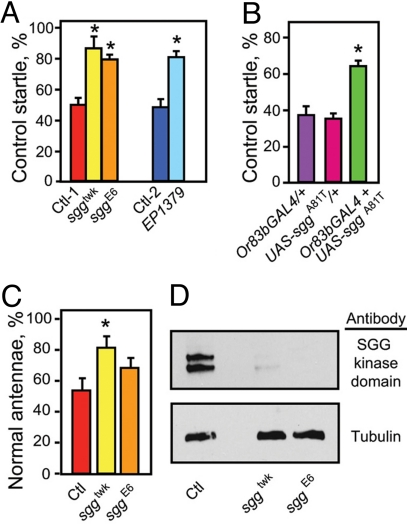Fig. 4.
Ethanol-induced ORN death requires Sgg/GSK3β. (A) Reduction of sgg function results in protection of the olfactory startle. Three loss-of-function alleles of sgg (twk, E6, and EP1379), all of which have a ≈90% reduction in the adult-specific forms of SGG (28), are resistant to ethanol-induced startle loss when compared with controls (Ctl-1 is a precise excision of the twk transposon and Ctl-2 is EP1576) (n = 7, *, P < 0.01 for twk and E6; *, P = 0.0013 for EP1379, Student's t test). (B) Expression of a dominant-negative allele of sgg (UAS-sggA81T) in the ORNs (using the Or83b-GAL4 driver) results in significant protection against ethanol-induced loss of olfactory startle (n = 4, *, P < 0.05). (C) sggtwk also demonstrates resistance to the ethanol-induced antennal-blackening phenotype (n = 7, *, P < 0.01), while sggE6 shows a trend toward resistance, although the data did not achieve statistical significance. (D) Western analysis demonstrates that adult-specific Sgg proteins are expressed in antennae, and that both sggtwk and sggE6 result in a strong reduction of these proteins. Each lane was loaded with protein from 30 dissected antennae.

